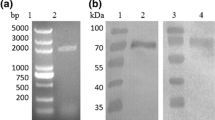Abstract
Glargine is an analog of Insulin currently being produced by recombinant DNA technology using two different hosts namely Escherichia coli and Pichia pastoris. Production from E. coli involves the steps of extraction of inclusion bodies by cell lysis, refolding, proteolytic cleavage and purification. In P. pastoris, a single-chain precursor with appropriate disulfide bonding is secreted to the medium. Downstream processing currently involves use of trypsin which converts the precursor into two-chain final product. The use of trypsin in the process generates additional impurities due to presence of Lys and Arg residues in the Glargine molecule. In this study, we describe an alternate approach involving over-expression of endogenous Kex2 proprotein convertase, taking advantage of dibasic amino acid sequence (Arg-Arg) at the end of B-chain of Glargine. KEX2 gene over-expression in Pichia was accomplished by using promoters of varying strengths to ensure production of greater levels of fully functional two-chain Glargine product, confirmed by HPLC and mass analysis. In conclusion, this new production process involving Kex2 protease over-expression improves the downstream process efficiency, reduces the levels of impurities generated and decreases the use of raw materials.





Similar content being viewed by others
References
Abad S, Kitz K, Hormann A, Schreiner U, Hartner FS, Glieder A (2010) Real-time PCR-based determination of gene copy numbers in Pichia pastoris. Biotechnol J 5(4):413–420
Brenner C, Fuller RS (1992) Structural and enzymatic characterization of a purified prohormone-processing enzyme: secreted soluble kex2 protease. Proc Natl Acad Sci U S A 89(3):922–926
Cereghino JL, Cregg JM (2000) Heterologous protein expression in the methylotrophic yeast Pichia pastoris. FEMS Microbiol Rev 24(1):45–66
Cregg JM, Cereghino JL, Shi J, Higgins DR (2000) Recombinant protein expression in Pichia pastoris. Mol Biotechnol 16(1):23–52
De Schutter K, Lin YC, Tiels P, Van Hecke A, Glinka S, Weber-Lehmann J, Rouze P, Van de Peer Y, Callewaert N (2009) Genome sequence of the recombinant protein production host Pichia pastoris. Nat Biotechnol 27(6):561–566
Duan H, Umar S, Hu Y, Chen J (2009) Both the AOX1 promoter and the FLD1 promoter work together in a Pichia pastoris expression vector. World J Microbiol Biotechnol 25:1779–1783
Germain D, Dumas F, Vernet T, Bourbonnais Y, Thomas DY, Boileau G (1992) The pro-region of the Kex2 endoprotease of Saccharomyces cerevisiae is removed by self-processing. FEBS Lett 299(3):283–286
Hazra P, Dave N, Kannan V, Tiwari S, Goel A, Iyer H, Roy N, Venkatesan K, Vasudevan A, Jagadish A, Sachdev G, Patale MB (2009) A method of obtaining purified heterologous insulins expressed in yeast. WO/2009/104199 A1
Li Z, Hansen JL, Liu Y, Zemetra ZS, Berger PH (2004) Using real-time PCR to determine transgene copy number in wheat. Plant Mol Biol Rep 22:179–188
Mizuno K, Nakamura T, Ohshima T, Tanaka S, Matsuo H (1989) Characterization of KEX2-encoded endopeptidase from yeast Saccharomyces cerevisiae. Biochem Biophys Res Commun 159(1):305–311
Muller F, Tieke A, Waschk D, Muhle C, Seigelchifer M, Pesce A, Jenzelewski V, Gellissen G (2002) Production of IFNα in Hansenula polymorpha. Process Biochem 38(1):15–25
Olsen JV, Ong SE, Mann M (2004) Trypsin cleaves exclusively C-terminal to arginine and lysine residues. Mol Cell Proteomics 3(6):608–614
Poon K, King AB (2010) Glargine and detemir: safety and efficacy profiles of the long-acting basal insulin analogs. Drug Healthc Patient Saf 2:213–223
Seeboth PG, Hein J (1991) In-vitro processing of yeast alpha factor leader fusion proteins using a soluble yscF (Kex2) variant. Appl Microbiol Biotechnol 35:771–776
Seidah NG, Gaspar L, Mion P, Marcinkiewicz M, Mbikay M, Chrttien M (1990) cDNA sequence of two distinct pituitary proteins homologous to kex2 and furin gene products: tissue specific mRNAs encoding candidates for prohormone processing proteinases. DNA Cell Biol 9:415–424
Seidah NG, Marcinkiewicz M, Benjannet S, Gaspar L, Beaubien G, Mattei MG, Lazure C, Mbikay M, Chrdtien M (1991) Cloning and primary sequence of a mouse candidate prohormone convertase PC1 homologous to PC2, Furin and kex2: distinct chromosomal localization and messenger RNA distribution in brain and pituitary compared to PC2. Mol Endocrinol 5:111–122
Smeekens SP, Steiner DF (1990) Identification of human insulinoma cDNA encoding a novel mammalian protein structurally related to the yeast dibasic processing protease kex2. J Biol Chem 265:2997–3000
Smeekens SP, Avruch AS, LaMendola J, Chan SJ, Steiner DF (1991) Identification of a cDNA encoding a second putative prohormone convertase related to PC2 in AtT20 cells and islets of Langerhans. Proc Natl Acad Sci U S A 88:340–344
Takahashi S, Ueda M, Tanaka A (2000) Effect of truncation of the C-terminal region of Kex2 endoprotease on processing of the recombinant Rhizopus oryzae lipase precursor in the co-expression system in yeast. J Mol Catal B Enzym 10:233–240
van den Ouweland AM, van Duijnhoven HL, Keizer GD, Dorssers LC, van de Ven WJ (1990) Structural homology between the human fur gene product and the subtilisin-like protease encoded by yeast KEX2. Nucleic Acids Res 18(5):1332
Waterham HR, Digan ME, Koutz PJ, Lair SV, Cregg JM (1997) Isolation of the Pichia pastoris glyceraldehyde-3-phosphate dehydrogenase gene and regulation and use of its promoter. Gene 186:37–44
Yang S, Kuang Y, Li H, Liu Y, Hui X, Li P, Jiang Z, Zhou Y, Wang Y, Xu A, Li S, Liu P, Wu D (2013) Enhanced production of recombinant secretory proteins in Pichia pastoris by optimizing Kex2 P1’ site. PLoS ONE 8(9):e75347. doi:10.1371/journal.pone.0075347
Yon J, Fried M (1989) Precise gene fusion by PCR. Nucleic Acids Res 17(12):4895
Zimmerman RE, Stokell DJ, Akers MP (2012) Glargine proinsulin and methods of producing glargine insulin analogs therefrom. US 20120214965 A1
Acknowledgments
We thank Molecular Biology group of R&D for their support and suggestions. We thank Biocon Research Limited for supporting this work.
Author information
Authors and Affiliations
Corresponding author
Rights and permissions
About this article
Cite this article
Sreenivas, S., Krishnaiah, S.M., Govindappa, N. et al. Enhancement in production of recombinant two-chain Insulin Glargine by over-expression of Kex2 protease in Pichia pastoris . Appl Microbiol Biotechnol 99, 327–336 (2015). https://doi.org/10.1007/s00253-014-6052-5
Received:
Revised:
Accepted:
Published:
Issue Date:
DOI: https://doi.org/10.1007/s00253-014-6052-5




